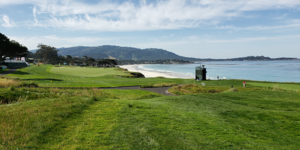Reverse the course: North America’s first 18-hole reversible course set to open
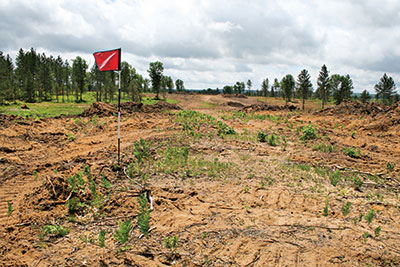
The 200-acre plot of land where The Loop was constructed fit Doak’s design perfectly because of the flat topography that allows for golfers to hit shots into greens from a variety of angles on the fairways.
Forest Dunes Golf Club’s agronomy crew is preparing for the opening of North America’s first 18-hole reversible course.
For more than 20 years, golf course architect Tom Doak has envisioned a golfing concept so unique and so rare that it never has been initiated in the United States — an 18-hole reversible course; essentially, two courses in one.
Renowned for “minimalist” courses like Oregon’s Pacific Dunes and Colorado’s Ballyneal, in which he routed his designs according to the natural features of the land, Doak first shared his vision in 2012 with Lew Thompson, owner of Roscommon, Mich.’s Forest Dunes Golf Club.
Thompson recently had purchased the 1,440-acre property, which included a par-72 Tom Weiskopf design, and then built Lake AuSable Lodge, a 14-room hotel, near the clubhouse. After finalizing the hotel, he was interested in developing a second course that would entice guests to stay and play at the club for multiple days.
Shortly after discussing the concept with Doak, Thompson approved construction of The Loop, North America’s first-ever 18-hole reversible course. By featuring 18 greens that could be played in two different routings — clockwise and counterclockwise — on alternative days, the course would exceed Thompson’s original expectations.
Not only would guests be welcomed to play three separate layouts, but because The Loop’s 36-hole design would be developed in the same amount of space as a typical 18-hole layout, Thompson has the option of building a fourth course.
Constructing The Loop
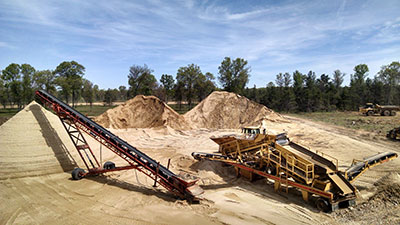
“The valleys were carved out to generate fill for mounding and create more rolling terrain, so that the course’s top lines were raised just enough that they were visible from the tees,” says Slawnik. “Most of the natural terrain dictated the layout though, so not much earth was moved.”
Ground broke during the fall of 2013 as a 200-acre site located west of the Weiskopf course was cleared and excavated.
The property’s flat topography was ideal for Doak’s reversible design, as it allowed golfers to hit shots into the greens from a variety of angles. Because the layout of the course will vary from one day to the next, it was important that the greens be set up to accept shots from different areas of the fairways.
To provide golfers a more challenging layout that was flat, but not excessively so, Forest Dunes’ agronomy team worked alongside design associates from Doak’s Renaissance Golf Design to develop some broad valleys near the greens and tees.
“The valleys were carved out to generate fill for mounding and create more rolling terrain, so that the course’s top lines were raised just enough that they were visible from the tees,” says Brian Slawnik, senior design associate for Renaissance Golf Design. “Most of the natural terrain dictated the layout though, so not much earth was moved.”
Aside from maintaining a relatively flat layout that will ease the irrigation process and lower maintenance costs, the designers and agronomy crew also limited the number of formal bunkers to approximately 40, opting for native sand hazards instead. In doing so, the crew was able to reduce turf area considerably, another critical component in irrigation cost decline.
“We also didn’t hardline the edges of the irrigated turf,” Slawnik adds. “Our hope is that the manicured turf will fade naturally as it transitions out to the native edges, so that they are not overwatered and remain as playable as possible.”
As a means of further cost reduction, Forest Dunes didn’t hire outside construction companies (a standard operating procedure for Renaissance Golf Design), and all equipment, aside from a bulldozer and excavator, had been previously purchased by the club. The agronomy team worked with Renaissance Golf Design associates on all aspects of construction until the final hole was seeded on Aug. 27, 2015.
“Constant communication with Brian Slawnik and the Renaissance team was key to our success,” says Brian Moore, Forest Dunes director of agronomy. “We met daily to discuss what needed to be completed, and really had to work well together as a team until we achieved our goals.”
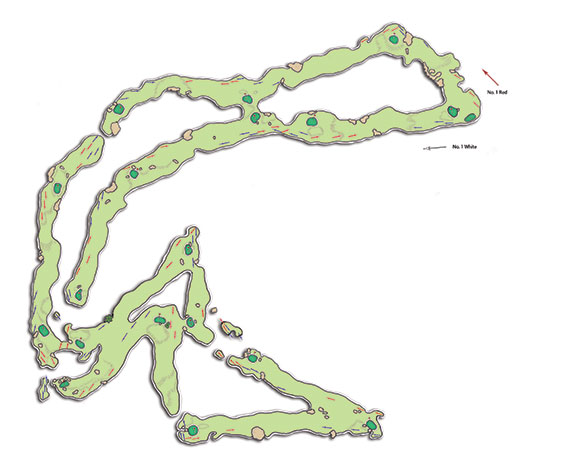 Minimal maintenance
Minimal maintenance
Although The Loop has only 18 maintained greens, its wide fairways, which were constructed specifically for the reversible layout, have resulted in a turf maintenance area of 95 acres — nearly twice as much as the average golf course.
In response, Moore and his 10 staff members intend to mow the back nine one day, starting with the 10th hole, then mow the other nine the next day, as the holes will alternate every other day. For instance, one day a hole will play as the 18th, but the next day it will play as the first, and vice versa.
In addition, the agronomy crew is preparing only two heights of cut: 1/8 inch for greens and ½ inch for fairways. To ensure that fairways don’t require frequent mowing, the entire course was grassed with a blend of fine fescue varieties, including Seabreeze Creeping Red, Navigator II Creeping Red, Radar Chewings and Chariot Hard.
“We have straight sand soil here, which is a good match for fine fescue,” says Moore. “Although fescue grows much slower than other grasses and is extremely tolerant to drought, its greatest downfall is its lack of wear tolerance, a potentially significant issue for a reversible course.”
To combat this lack of tolerance, The Loop will be a walking-only course, while its tees and green surrounds will have Puritan Colonial bentgrass for further protection. Additionally, it’s expected that alternating play on the two routings every other day will better distribute wear and divot patterns.
“Since fine fescue also requires less fertilizer inputs, my ultimate goal is to use 0.5 pounds of nitrogen per 1,000 square feet each year,” Moore adds. “Overall operating costs should decline as a result.”
During the spring of 2015, Moore and his crew received a custom blend fairway pre-plant fertilizer from Harrell’s: a 25-8-12 Polyon product with a micro-nutrient package. Starting in May, 12 pounds of the product were applied per 1,000 square feet of fine fescue, resulting in 3 pounds of nitrogen per 1,000 square feet.
“The Polyon gave us an extended, controlled release of nutrients over a four-month period,” Moore states. “Although the first fairways that were seeded in May required a supplemental feeding in September, the fairways seeded in August did not require another feeding.”
Because of the fertilizer’s initial success, Moore will apply a similar product in early to mid-May 2016, but rather than 3 pounds of nitrogen per 1,000 square feet, they’ll apply only 1.25 pounds of nitrogen per 1,000 square feet, 0.25 pounds of which will be ammonium sulfate. In late August or early September, Moore will repeat the process but diminish the total even further by applying only 1 pound of nitrogen per 1,000 square feet.
Conserving natural and financial resources
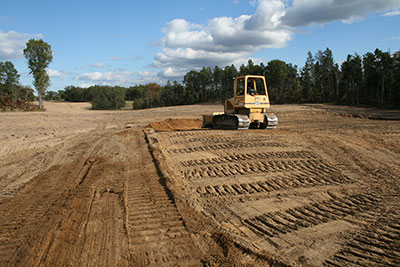
As a means of further cost reduction, Forest Dunes didn’t hire outside construction companies, and all equipment, aside from a bulldozer and excavator, had been previously purchased by the club.
In 2015, Moore and his crew worked with Michael Kuhn & Associates, Inc., an irrigation design consulting company based in Auburn Hills, Mich., to develop a system that will irrigate only The Loop’s maintained turf areas.
The consultants, alongside Moore’s crew, designed a two-row system that will keep water in the middle of the maintained turf so that it doesn’t spray onto edges and native grasses. Wider fairways will be watered with either a three- or a four-row system, again spraying water only on the maintained turf. The implications will be twofold: Forest Dunes will notice considerable water and cost savings, and native plants will continue to grow as they have for years.
“From a playability standpoint, keeping water off of the native plants is key,” Moore says. “If they remain thin, golfers will be able to find their balls and have an opportunity to get them back into play.”
Beginning on June 27, 2016, the public will be welcomed to play The Loop. However, for this season only, golfers must be overnight resort guests — a policy that should spark their interests in playing each of the club’s golf courses.
“Renaissance Golf Design has always tried to build courses with features that lead people to want to go out and play again and again,” Doak says. “But The Loop has taken that to another level.”
“The Loop has exceeded our team’s expectations,” adds Chad Maveus, general manager and director of golf for Forest Dunes. “Once people start playing it, Forest Dunes will become one of Michigan’s leading destinations for golf.”
Photos by: Brian Moore, Brian Walters









